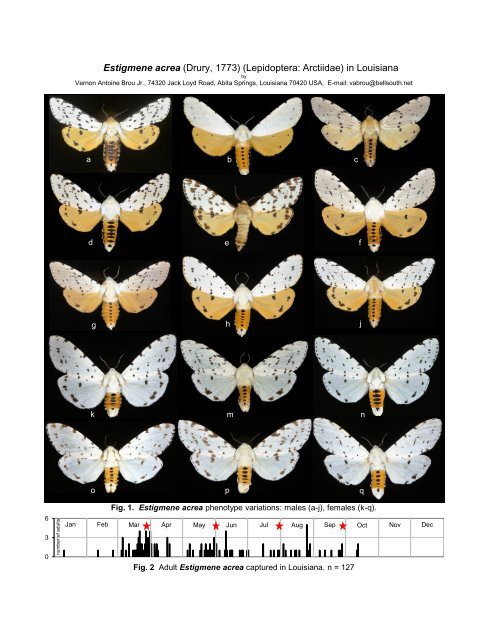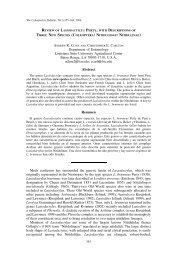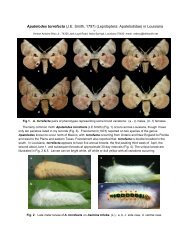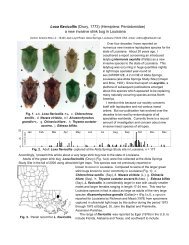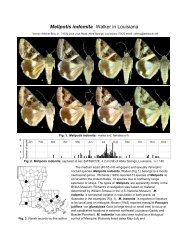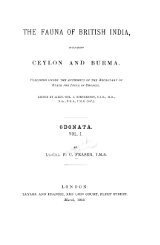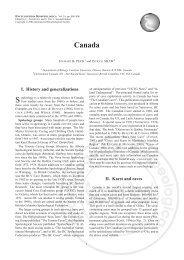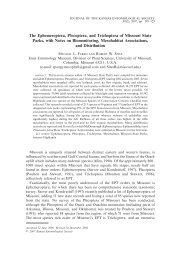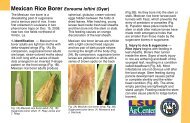Estigmene acrea (Drury, 1773) (Lepidoptera: Arctiidae) in Louisiana
Estigmene acrea (Drury, 1773) (Lepidoptera: Arctiidae) in Louisiana
Estigmene acrea (Drury, 1773) (Lepidoptera: Arctiidae) in Louisiana
You also want an ePaper? Increase the reach of your titles
YUMPU automatically turns print PDFs into web optimized ePapers that Google loves.
<strong>Estigmene</strong> <strong>acrea</strong> (<strong>Drury</strong>, <strong>1773</strong>) (<strong>Lepidoptera</strong>: <strong>Arctiidae</strong>) <strong>in</strong> <strong>Louisiana</strong><br />
by<br />
Vernon Anto<strong>in</strong>e Brou Jr., 74320 Jack Loyd Road, Abita Spr<strong>in</strong>gs, <strong>Louisiana</strong> 70420 USA, E-mail: vabrou@bellsouth.net<br />
a b c<br />
d<br />
e<br />
f<br />
g h j<br />
k<br />
m<br />
n<br />
o p q<br />
6<br />
3<br />
0<br />
number of adults<br />
Fig. 1. <strong>Estigmene</strong> <strong>acrea</strong> phenotype variations: males (a-j), females (k-q).<br />
Jan Feb Mar Apr May Jun Jul Aug Sep Oct Nov Dec<br />
Fig. 2 Adult <strong>Estigmene</strong> <strong>acrea</strong> captured <strong>in</strong> <strong>Louisiana</strong>. n = 127
The common arctiid species <strong>Estigmene</strong> <strong>acrea</strong> (<strong>Drury</strong>, <strong>1773</strong>)<br />
(Fig. 1) is reported <strong>in</strong> various literature of the times to <strong>in</strong>clude<br />
southern Canada to Colombia and Cuba. It occurs throughout<br />
much of the United States, coast to coast. This species is quite<br />
variable with respect to its forew<strong>in</strong>g and h<strong>in</strong>dw<strong>in</strong>g maculation. A<br />
small number of specimens taken dur<strong>in</strong>g this study exhibited a<br />
character previously reported for several species of the family<br />
<strong>Arctiidae</strong>, <strong>in</strong>clud<strong>in</strong>g <strong>acrea</strong> as hav<strong>in</strong>g the "greasy w<strong>in</strong>g gene"<br />
attribute <strong>in</strong> which the usual white forew<strong>in</strong>g basal color appears<br />
as a dull vitreous gray color (Fig. 1c, g, and m) and to a lesser<br />
extent <strong>in</strong> Figs. 1d, and f .<br />
Based on my records from a rather small sample population,<br />
there appears to be at least four annual broods with<strong>in</strong> <strong>Louisiana</strong>,<br />
identified by red markers <strong>in</strong> Fig. 2. Numerous authors. e.g.<br />
Fig. 3. Parish records for E. <strong>acrea</strong>. Covell (1984) list the same <strong>in</strong>formation concern<strong>in</strong>g the number<br />
of broods "May-Aug.; 2 broods".<br />
Some of the <strong>in</strong>formation concern<strong>in</strong>g various physical and biological attributes about this species available<br />
<strong>in</strong> past and present entomological literature as well as <strong>in</strong>formation currently on the <strong>in</strong>ternet is <strong>in</strong>valid, either<br />
based on <strong>in</strong>sufficient <strong>in</strong>formation and/or unsubstantiated statements and assumptions from past literature.<br />
This species was previously reported for <strong>Louisiana</strong> by Stracener (1931) and was reported captured on an<br />
offshore oil platform off the coast of <strong>Louisiana</strong> <strong>in</strong> the Gulf of Mexico (Russell, 2005).<br />
The parish records by this author are illustrated <strong>in</strong> Fig.3.<br />
Literature cited<br />
Covell, Jr., C.V. 1984. A field guide to the moths of eastern North America. The Peterson Field Guide Series No. 30. Houghton Miffl<strong>in</strong><br />
Co., Boston. xv + 496pp., 64 plates.<br />
Russell, R.W. 2005. Interactions between migrat<strong>in</strong>g birds and offshore oil and gas platforms <strong>in</strong> the northern Gulf of Mexico: F<strong>in</strong>al<br />
Report. U.S. Dept. of the Interior, M<strong>in</strong>erals Management Service, Gulf of Mexico OCS Region, New Orleans, LA. OCS Study<br />
MMS 2005-009. 348 pp.<br />
Stracener CL. 1931. Economic importance of the salt-marsh caterpillar (<strong>Estigmene</strong> acraea <strong>Drury</strong>) <strong>in</strong> <strong>Louisiana</strong>. Journal of Economic<br />
Entomology 24: 835-838


